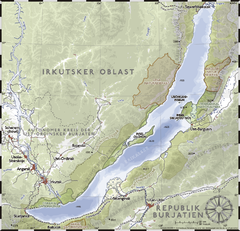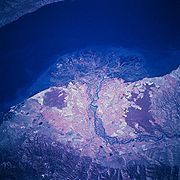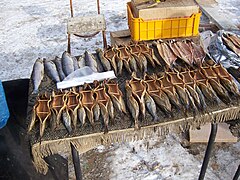বৈকাল হ্ৰদ
| বৈকাল হ্ৰদ (Lake Baikal) | |
|---|---|

| |

| |
| অৱস্থান | Siberia, Russia |
| স্থানাংক | 53°30′N 108°0′E / 53.5°N 108°Eস্থানাংক: 53°30′N 108°0′E / 53.5°N 108°E |
| Primary inflows | Selenge, Barguzin, Upper Angara |
| Primary outflows | Angara |
| Catchment area | 5,60,000 বৰ্গ কি.মি. (5.60000000×1011 বৰ্গ মিটাৰ) |
| Basin countries | Russia and Mongolia |
| Max. length | 636 km (395 মাইল) |
| Max. width | 79 km (49 মাইল) |
| Surface area | 31,722 বৰ্গ কি.মি. (3.1722×1010 বৰ্গ মিটাৰ)[1] |
| Average depth | 744.4 মিটাৰ (2,442 ফুট)[1] |
| Max. depth | 1,642 মিটাৰ (5,387 ফুট)[1] |
| Water volume | সাঁচ:Convert/km3[1] |
| Residence time | 330 years[2] |
| Shore length1 | 2,100 km (1,300 মাইল) |
| Surface elevation | 455.5 মিটাৰ (1,494 ফুট) |
| Frozen | January–May |
| Islands | 27 (Olkhon) |
| Settlements | Irkutsk |
| 1 Shore length is not a well-defined measure. | |
বৈকাল হ্ৰদ (ৰুছ: о́зеро Байка́л, tr. Ozero Baykal; IPA: [ˈozʲɪrə bɐjˈkɑl]; সাঁচ:Lang-bxr, মঙ্গোলিয়: Байгал нуур, Baygal nuur, meaning "nature lake";[3]) ৰাছিয়াৰ দক্ষিণ ছাইবেৰিয়াত অৱস্থিত এটা হ্ৰদ৷ ইয়াৰ উত্তৰ-পশ্চিমে Irkutsk Oblast আৰু পূব-দক্ষিণে বুৰিয়াট ৰিপাব্লিক (Buryat Republic) অৱস্থিত ৷
বৈকাল হ্ৰদ সমগ্ৰ বিশ্বৰ ভিতৰতে আয়তনৰ ফালৰ পৰা সৰ্ববৃহৎ নিৰ্মল পানীৰ হ্ৰদ (freshwater lake) ৷ এই হ্ৰদে বিশ্বৰ প্ৰায় ২০% নিৰ্মল আৰু গোট নমৰা পানী (unfrozen surface fresh water.) ধৰি ৰাখিছে ৷[4][5] এই হ্ৰদৰ গভীৰতা 1,642 মিটাৰ (5,387 ফুট)[1] যাৰ বাবে ই বিশ্বৰ আটাইতকৈ গভীৰ হ্ৰদ বুলিও স্বীকৃত ৷[6] তাৰোপৰি এই হ্ৰদক বিশ্বৰ আটাইতকৈ পৰিস্কাৰ বা নিৰ্মল[7] আৰু ২৫ মিলিয়ন বৰ্ষৰ পূৰ্বে সৃষ্টি হোৱাৰ বাবে আটাইতকৈ প্ৰাচীন[8][9] হ্ৰদ ৰূপে স্বীকৃতি দিয়া হয় ৷ কালি (surface area) ৰ দিশৰ পৰা ইয়াৰ স্থান বিশ্বৰ ভিতৰত সপ্তম ৷ সাঁচ:Convert/km3 পানীৰে[1] এই হ্ৰদে উত্তৰ আমেৰিকাৰ বৃহৎ হ্ৰদ (Great Lakes) সমূহতকৈও অধিক পানী ধৰি ৰাখিছে ৷[10]
ইতিহাস
[সম্পাদনা কৰক]টাংগান্যিকা হ্ৰদৰ দৰেই বৈকাল হ্ৰদৰো এক প্ৰাচীন প্ৰাচীৰ উপত্যকা (ancient rift valley) ৰূপে সৃষ্টি হৈছিল ৷ সেইসময়ত ইয়াৰ কালি আছিল 31,722 বৰ্গ কি.মি. (12,248 বৰ্গ মাইল) ৷
গুৰুত্ব
[সম্পাদনা কৰক]বৈকাল হ্ৰদ প্ৰায় ১,৭০০ বিভিন্ন উদ্ভিদ আৰু প্ৰাণীৰ গৃহভূমি ৷ ইয়াৰে দুই-তৃতীয়াংশ জীৱ পৃথিৱীৰ অন্য কোনো ঠাইতে পোৱা নাযায় ৷[11] ১৯৯৬ চনত এই হ্ৰদক ইউনেস্কই ৱৰ্ল্ড হেৰিটেজ ছাইট ৰূপে স্বীকৃতি দিয়ে ৷[12] এই হ্ৰদ বুৰিয়াট জনজাতি (Buryat tribes) ৰো গৃহভূমি৷[13][14] এই লোকসকলৰ প্ৰধান বৃত্তি পশুপালন৷ [14] এই অঞ্চলত সৰ্বনিম্ন তাপমাত্ৰা সাঁচ:Convert/−1 °C (−2 °F) আৰু সৰ্বোচ্চ তাপমাত্ৰা 14 °C (57 °F).[15]
আলোকচিত্ৰৰ ভঁৰাল
[সম্পাদনা কৰক]-
Lake Baikal as seen from the OrbView-2 satellite
-
Spring ice melt underway on Lake Baikal
-
Circle of thin ice, diameter of 4.4 km (2.7 মাইল) at the lake's southern tip, probably caused by convection
-
Delta of the Selenga River, Baikal's main tributary
-
Mountains seen from the banks of Baikal
-
View of Lake Baikal
-
Shamanka, or Shaman's Rock on Olkhon Island
-
Icebound shore of Baikal in early April, at Listvyanka
-
Pod of seals on Baikal
-
Late 19th-century steam icebreaker Baikal in port
-
Baikal omul at market
তথ্যসূত্ৰ
[সম্পাদনা কৰক]- ↑ 1.0 1.1 1.2 1.3 1.4 1.5 "A new bathymetric map of Lake Baikal. MORPHOMETRIC DATA. INTAS Project 99-1669.Ghent University, Ghent, Belgium; Consolidated Research Group on Marine Geosciences (CRG-MG), University of Barcelona, Spain; Limnological Institute of the Siberian Division of the Russian Academy of Sciences, Irkutsk, Russian Federation; State Science Research Navigation-Hydrographic Institute of the Ministry of Defense, St.Petersburg, Russian Federation". Ghent University, Ghent, Belgium. Archived from the original on 25 December 2018. https://web.archive.org/web/20181225085935/http://users.ugent.be/~mdbatist/intas/morphometry.htm। আহৰণ কৰা হৈছে: 9 July 2009.
- ↑ M.A. Grachev. "On the present state of the ecological system of lake Baikal". Lymnological Institute, Siberian Division of the Russian Academy of Sciences. Archived from the original on 25 December 2018. https://web.archive.org/web/20181225085939/http://lin.irk.ru/en/ecological-system/introduction। আহৰণ কৰা হৈছে: 9 July 2009.
- ↑ Altangerel Damdinsuren, English to Mongolian Dictionary (1998) Silverland: A Winter Journey Beyond the Urals, London, John Murray, page 173
- ↑ "Lake Baikal: the great blue eye of Siberia". CNN. Archived from the original on 11 October 2006. http://www.cnn.com/SPECIALS/2000/russia/story/train/lake.baikal/। আহৰণ কৰা হৈছে: 21 October 2006.
- ↑ উদ্ধৃতি ত্ৰুটি: অবৈধ
<ref>টেগ;odditiesনামৰ refৰ বাবে কোনো পাঠ্য প্ৰদান কৰা হোৱা নাই - ↑ "Deepest Lake in the World". geology.com. http://geology.com/records/deepest-lake.shtml। আহৰণ কৰা হৈছে: 18 August 2007.
- ↑ Jung, J.; Hojnowski, C., Jenkins, H., Ortiz, A., Brinkley, C., Cadish, L., Evans, A., Kissinger, P., Ordal, L., Osipova, S., Smith, A., Vredeveld, B., Hodge, T., Kohler, S., Rodenhouse, N. and Moore, M. (2004). "Diel vertical migration of zooplankton in Lake Baikal and its relationship to body size". In Smirnov, A.I.; Izmest'eva, L.R.. Ecosystems and Natural Resources of Mountain Regions. Proceedings of the first international symposium on Lake Baikal: The current state of the surface and underground hydrosphere in mountainous areas. "Nauka", Novosibirsk, Russia. পৃষ্ঠা. 131–140. Archived from the original on 15 June 2011. http://www.wellesley.edu/Biology/Faculty/Mmoore/Content/JUNG_et_al_2004.pdf। আহৰণ কৰা হৈছে: 9 August 2009.
- ↑ Fact Sheet: Lake Baikal — A Touchstone for Global Change and Rift Studies, July 1993 (accessed 4 December 2007)
- ↑ "Lake Baikal – UNESCO World Heritage Centre". http://whc.unesco.org/en/list/754। আহৰণ কৰা হৈছে: 5 October 2012.
- ↑ 1001 natural wonders : you must see before you die. preface by Koichiro Mastsuura (2009 সম্পাদনা). প্ৰকাশক London: Cassell Illustrated. 2010. পৃষ্ঠা. 620. ISBN 9781844036745.
- ↑ "Russia". Britannica Student Encyclopedia. Encyclopædia Britannica Online. 2007. Retrieved 3 July 2007.
- ↑ "Lake Baikal — World Heritage Site". World Heritage. http://whc.unesco.org/en/list/754। আহৰণ কৰা হৈছে: 13 January 2007.
- ↑ M. Hammer and T. Karafet (1995). "DNA & the peopling of Siberia". Smithsonian Institution. http://www.mnh.si.edu/arctic/html/peopling_siberia.html। আহৰণ কৰা হৈছে: 9 August 2009.
- ↑ 14.0 14.1 S. Hudgins (2003) (PDF). The Other Side of Russia: A Slice of Life in Siberia and the Russian Far East. Texas A&M University Press. http://www.tamupress.com/product/Other-Side-of-Russia,4080.aspx। আহৰণ কৰা হৈছে: 9 August 2009.
- ↑ Fefelov, I.; Tupitsyn, I. (August 2004). "Waders of the Selenga delta, Lake Baikal, eastern Siberia" (PDF). Wader Study Group Bulletin খণ্ড 104: 66–78. http://sora.unm.edu/sites/default/files/journals/iwsgb/v104/p00066-p00078.pdf। আহৰণ কৰা হৈছে: 9 August 2009.
বাহ্যিক সংযোগ
[সম্পাদনা কৰক]| ৱিকিমিডিয়া কমন্সত Lake Baikal সম্পৰ্কীয় মিডিয়া ফাইল আছে। |











